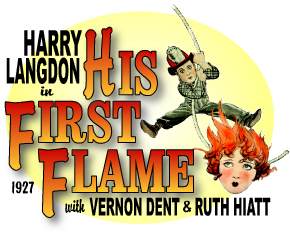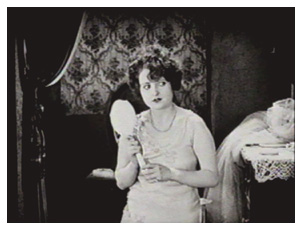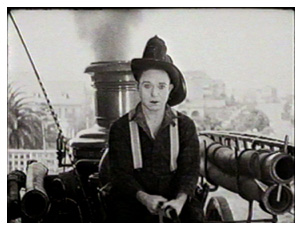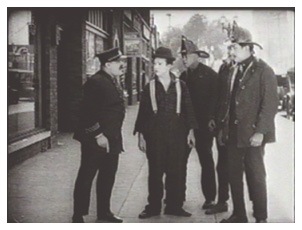

Produced by Mack Sennett
Distributed by Pathe Pictures
Directed by Harry Edwards
Released May 8, 1927
Cast: Harry Langdon (Harry Howells), Ruth Hiatt (Mary Morgan),
Natalie Kingston (Ethel Morgan), Vernon Dent (Amos McCarthy),
Bud Jamison (Hector Benedict), Dot Farley (Mrs. Benedict)
It seems there are two camps regarding Harry Langdon - those who really love him and those who don't see the humor in his films. I'm one of those who has a foot in both camps. By that, I mean, there are Harry Langdon films out there that I think are hilarious - our feature film here, for one. Then, there are those that fall short in both story and gags, leaving the viewer with a less than satisfied feeling.
However, this tome is not to analyze Langdon's career but
to talk a bit about "His First Flame" (1927), a delightful
little (only 5 reels) comedy that shows us both Langdon and  Mack Sennett at their best. And
I can pretty much guarantee that even the harshest Langdon critic
will find some laughs in this gag-filled film.
Mack Sennett at their best. And
I can pretty much guarantee that even the harshest Langdon critic
will find some laughs in this gag-filled film.
One unusual tidbit about "His First Flame" is that it was made while Langdon was at Sennett, but released almost two years later after the comedian had made three films for First National - "Tramp, Tramp, Tramp," "The Strong Man" (1926) and "Long Pants" (1927). Sennett wisely sat on the film letting First National build up the star's reputation before releasing the feature he produced. Apparently it worked, because "His First Flame" was a success and was mostly well received by critics, including the often-disdainful Mordaunt Hall of the New York Times. He said, "Mr. Sennett and Mr. Langdon do their parts in this nice mile of fun. Mr. Sennett . . . deserves no little credit for the hilarious situations in this picture. And Mr. Langdon is to be congratulated on a generous supply of sad smiles and wide-eyed effects. . . Mr. Langdon is at his best in this humorous piece of work." (1) Photoplay criticized Sennett for sitting on the film, but still considered the film worth seeing. "Langdon is, was and always will be funny, but it is just a plain low trick to show this to audiences. The lighting is bad, the girls' clothes are a scream - in fact, the picture looks like a number of two-reelers pasted together - but Harry is always worth the price of admission." (2)
Langdon biographer William Schelley said, " . . . the comedian couldn't have been embarrassed by the contents of the unexpected time capsule. Most often, the material from an actor's early career hardly merits a revival. But Langdon had no cause to be ashamed of the Sennett film, for 'His First Flame' ranks with 'Saturday Afternoon' and 'Fiddlesticks' (two Sennett two-reelers) as one of the best of the comedies shot in Edendale."
Photoplay is not far off in saying it "looks like a number of two-reelers pasted together." However, it is satisfactorily held together by a story of Harry being in love with a gold digger, Ethel, while Ethel's little sister, Mary, thinks Harry is the pip. So, here's an exchange between the two sisters that illustrates the basis for the story. Ethel has just read a telegram from Harry asking her to come hear his college graduation speech. Ethel throws it down.
The narrative rounds out with Harry's fireman uncle, Amos McCarthy, who, after three marriages, hates women and vows to keep his nephew from even thinking about a girl. In an amusing scene between the two, Harry has just been told by his uncle that the only reason this girl wants to marry him is because of his money. When uncle tells him to "forget it," Harry says he will think about it. He then gets up, picks up a box of chocolates and a bouquet of flowers and starts to leave - that is, until he sees his uncle's threatening glare. Harry looks down momentarily at the gifts, thinks about his predicament for maybe three seconds, then happily hands them over to his uncle. "I bought 'em for you!" he says.
Later Harry buys more chocolates and flowers and can be seen peeking very tentatively from around the corner of the shop to make sure his uncle is nowhere around. Langdon is admittedly the master of such hesitation, and his constant wide-eyed, timid demeanor defines his character. Of course, in a comedy such as this, we really don't believe these gifts will survive to get to the girl, either, do we?? Of course not! As he gets into the cab, the cab door slams on the flowers, and they are clipped off only to leave him holding the stems. Of course, Harry is looking straight ahead, holding the stems upright just as if he has a large bouquet of delicate flowers in his hand. He even leans forward to smell them. Then he sits back up and does a double take, something Langdon does with minimal head movement and eye widening, but ever so funny! Disgusted, he throws the stems toward the car window, but the window is closed. He reaches over to lower the window, accidently grabs the candy box, and throws it out the window. It takes second or two for the mistake to soak in, but shocked at what he has done, he jumps out of the moving cab, lands on his feet running, and then scampers toward the candy box just as a delivery truck runs over them. Now that's a funny sequence!
The film is filled with gag sequences such as this - and,
as would be expected in a Sennett film, they aren't all necessarily
connected to the basic storyline. For example, he is invited by
an old friend he encounters on the street, the incomparable Bud
Jamison, to his home to meet the wife and have dinner. Harry gets
caught in the middle of a family squabble,  and
every time he steps out on the balcony to look across the way
at a couple fighting in the next apartment building, Jamison's
wife slugs him and knocks him to the floor. Once, Jamison slugs
his wife, and when Harry comes back in, he just assumes she has
been drinking too much and shakes a disapproving finger at her
accompanied by a knowing smile. Innocently commenting on the couple
across the way, Harry tells the wife, "Seems to be a lot
of fighting around here!" She responds, "No more than's
necessary!" With husband and wife on either end of the table,
Harry sits on one side ready to partake of a peaceful meal, unaware
still at this point that there has been any fighting in this household.
Suddenly, Jamison shouts and points an angry finger at his wife.
Harry literally comes up out of the chair and runs for the balcony,
terrified. The husband announces he's going somewhere where he
can eat in peace and gets his hat from the hat rack. Harry takes
his hat, as well, thinking that they are leaving - that is, until
the wife pulls out a large knife and threatens the husband, "You'll
do nothing of the kind, so help me!" Harry, still wide-eyed
and having yet to take his hand off his hat, looks at the wife,
then the husband, then back at the knife in the wife's hand. He
reaches out and takes the husband's hat to hang on the rack. Hanging
his on the rack, as well, he points timidly to the table for the
husband to sit down, all the while keeping a watchful eye on the
wife lest he need to run.
and
every time he steps out on the balcony to look across the way
at a couple fighting in the next apartment building, Jamison's
wife slugs him and knocks him to the floor. Once, Jamison slugs
his wife, and when Harry comes back in, he just assumes she has
been drinking too much and shakes a disapproving finger at her
accompanied by a knowing smile. Innocently commenting on the couple
across the way, Harry tells the wife, "Seems to be a lot
of fighting around here!" She responds, "No more than's
necessary!" With husband and wife on either end of the table,
Harry sits on one side ready to partake of a peaceful meal, unaware
still at this point that there has been any fighting in this household.
Suddenly, Jamison shouts and points an angry finger at his wife.
Harry literally comes up out of the chair and runs for the balcony,
terrified. The husband announces he's going somewhere where he
can eat in peace and gets his hat from the hat rack. Harry takes
his hat, as well, thinking that they are leaving - that is, until
the wife pulls out a large knife and threatens the husband, "You'll
do nothing of the kind, so help me!" Harry, still wide-eyed
and having yet to take his hand off his hat, looks at the wife,
then the husband, then back at the knife in the wife's hand. He
reaches out and takes the husband's hat to hang on the rack. Hanging
his on the rack, as well, he points timidly to the table for the
husband to sit down, all the while keeping a watchful eye on the
wife lest he need to run.
This sequence goes on with Harry sitting in a chair while the two hover over him fighting back and forth, trying to bring Harry into their squabble. Situations such as this suited Langdon so well, giving his childlike, innocent nature a chance to tremble in the adult world in which he is so inept. And just like a child, he sides with the wife when she has a vase in her hand as a weapon, but then changes his allegiance to the husband when he picks up a larger vase. Classic Langdon!!
After this trying episode, Harry is walking down the street and encounters a couple he had met earlier pushing a baby buggy. Not realizing they are shoplifters being chased by the police, he puts his hand out to greet them. Just as that moment, the man passes a sap to the woman and Harry, terrified at the sight of the weapon, runs part of the way down the block, stops and looks back. At that moment, the man dashes off in the opposite direction, and the woman runs straight toward Harry. Of course, Harry thinks she's chasing him with the sap and runs ahead of her. Just as he stops to look back, she slips past him into a doorway to hide. The camera gives us a view straight down the sidewalk with Harry standing there, facing the camera, puzzled at the sudden disappearance of the woman. Suddenly, a hand appears out of the doorway with a sap and raps Harry on his head. He stands rigid, then sways ever so slowly to the left, feet firmly glued to the ground, legs stiff. He then sways to the right like a tree about to topple eventually falling over in the doorway. Very shortly, the woman comes out with Harry's clothes on followed by a dazed Harry dressed in a woman's attire, hat and all.
There is a very funny, brief gag that follows right after this when Harry catches a ride. We see him get in the car, then, about a block down the street, the door opens quickly and Harry come out in one quick jump, looking back in wonderment about what happened inside that car. Obviously, the driver booted Harry out when he realized this wasn't the gender he expected. It's an ingenious bit of business!
Once Harry makes it back to the fire station, his uncle is disgusted with him. Looking at his nephew in a dress, he says angrily, "-and I thought College would make a man out of you!" Uncle sends him upstairs to bed, which, of course, causes all the firemen - some in their underclothes - to go scurrying away when this "woman" comes in.
There's much humor to be found surrounding the firehouse,
fire trucks and burning buildings, and Langdon and Sennett make
the most of it. Soon after getting back to the  firehouse,
Harry accompanies his uncle in responding to a fire in an apartment
building. Harry sits on a curb watching with admiration as his
uncle rushes into the burning structure. Soon after his uncle
disappears into the smoke and flames, he looks up to see Ethel
at the upstairs window shouting for help. Harry fights off several
firemen who try to prevent him from going into this dangerous
situation and rushes into the building, as well. Within moments,
the uncle climbs down the ladder with Ethel over his shoulder.
Upon reaching the ground, he carries her away from the fire to
revive her. Next we see Harry come out of the upstairs window
and down the ladder with what appears to be a second female. As
the camera moves in, we realize he has a mannequin. Obviously,
it takes Harry a little longer to realize he doesn't have a real
person, and the quizzical look and second takes, followed by looks
of embarrassment, are priceless!
firehouse,
Harry accompanies his uncle in responding to a fire in an apartment
building. Harry sits on a curb watching with admiration as his
uncle rushes into the burning structure. Soon after his uncle
disappears into the smoke and flames, he looks up to see Ethel
at the upstairs window shouting for help. Harry fights off several
firemen who try to prevent him from going into this dangerous
situation and rushes into the building, as well. Within moments,
the uncle climbs down the ladder with Ethel over his shoulder.
Upon reaching the ground, he carries her away from the fire to
revive her. Next we see Harry come out of the upstairs window
and down the ladder with what appears to be a second female. As
the camera moves in, we realize he has a mannequin. Obviously,
it takes Harry a little longer to realize he doesn't have a real
person, and the quizzical look and second takes, followed by looks
of embarrassment, are priceless!
Walking away from the commotion, he happens to see his uncle and Ethel in the back of a car kissing. Harry is crushed to see his fiancée in another man's arms. Mary sees this broken-hearted scene, and decides she is going to do something about it - so she stages her own fake fire at her house hoping Harry will respond - and he does. The finale is rousing and gag-filled as Harry drives the horse-drawn steamer down the road in a dash worthy of a Harold Lloyd film. Although Mary has rigged a small smoke pot in the middle of the room, Harry's steamer, parked under a window, sends billows of smoke into the house making everyone think the structure really is on fire! After a flurry of fast-paced gags, one on top of the other, Harry, of course, rescues Mary just as Uncle arrives. With Mary in his arms, he looks at the heretofore woman-hating uncle and runs down the street carrying his new love, determined not to lose this one!
Some may consider the first three First National-Langdon films - "The Strong Man," "Long Pants" or "Tramp, Tramp, Tramp" - to be better films, and certainly they exhibit better production values, if not stronger storylines, as well. However, "His First Flame" stands on its own as great fun and about 50 minutes filled with an abundance of laughs. Admittedly, the Frank Capra-Langdon collaboration seemed to be a good match for Langdon. The three First National films mentioned above were received well, but, unfortunately, subsequent Langdon films without Capra were not successful. For a more in-depth look at this relationship and Langdon's rise and fall, read William Schelley's excellent biography "Harry Langdon: His Life and Films." Click here to read the Silents Are Golden review of this book.
Much is added to the film by the presence of Bud Jamison as the battling husband and long-time Langdon associate Vernon Dent as Uncle Amos McCarthy. Jamison had already been in films for 10 years by the time he filmed "His First Flame" in 1925 and went on to appear in an amazing 483 films before his untimely death at age 49 in 1944. Born the same year as Jamison, 1895, Dent appeared in 428 films between 1919 and 1957. Those of us from the television generation most likely had our first exposure to these two great supporting comedians in Three Stooges films.
Langdon actually came on the scene rather late, comparatively
speaking. He was a full 11 years older than Jamison and Dent having
been born in 1884. His fame was first made in  vaudeville
where he developed the baby face character and utilized it with
great success. Sennett enticed him into film in 1924 at age 40,
but Langdon was still able to pull off the innocent cherub bit
and did so splendidly! His 23 shorts and one feature for Sennett
took him to new heights of popularity, enough that First National
was willing to entice him away with as six-picture deal and his
own production company. Although his star fell almost faster than
it rose as a result of the box office failure of the final First
National features, Langdon continued acting at poverty row studios,
sometimes in shorts, sometimes in features - and stayed employed
fairly consistently in spite of some occasional financial and
personal difficulties.
vaudeville
where he developed the baby face character and utilized it with
great success. Sennett enticed him into film in 1924 at age 40,
but Langdon was still able to pull off the innocent cherub bit
and did so splendidly! His 23 shorts and one feature for Sennett
took him to new heights of popularity, enough that First National
was willing to entice him away with as six-picture deal and his
own production company. Although his star fell almost faster than
it rose as a result of the box office failure of the final First
National features, Langdon continued acting at poverty row studios,
sometimes in shorts, sometimes in features - and stayed employed
fairly consistently in spite of some occasional financial and
personal difficulties.
Of the 96 films in his filmography, certainly "His First Flame" ranks as one of the best and an above-average comedy feature from the silent era. As Schelley pointed out, "What 'His First Flame' lacks in cinematic style and narrative development, it compensates for with plentiful gags and an upbeat mood." (3) Other reviews were quick to criticize the film's lack of "cinematic style and narrative development," but, nevertheless, recommended it, albeit with slight reservations. Harrison's Reports said it was "Not up to the standard of Harry Langdon's best pictures," and "There is nothing to the plot," yet admitted, "Harry Langdon puts over a lot of gags," and it will "probably amuse audiences in the smaller houses." (4) Variety described it as "A gag picture, running through a story of no consequence, but with laughs enough from the Harry Langdon gags to make this picture stand up as that kind of comedy." The review closed with "Wherever Langdon has made himself, this can follow right in either before or after 'Long Pants'." (5)
Sources
1. Hall, Mordaunt. "His First Flame" review. The
New York Times. May 7, 1927.
2. "His First Flame" review. Photoplay. July 1927.
3. Schelley, William. Harry Langdon: His Life and Films. Second
Edition. McFarland & Company, Inc. 2008.
4. "His First Flame" review. Harrison's Reports. May
14, 1927.
5. "His First Flame" review. Variety. May 11, 1927.
Copyright 2013 by Tim Lussier. All rights reserved.